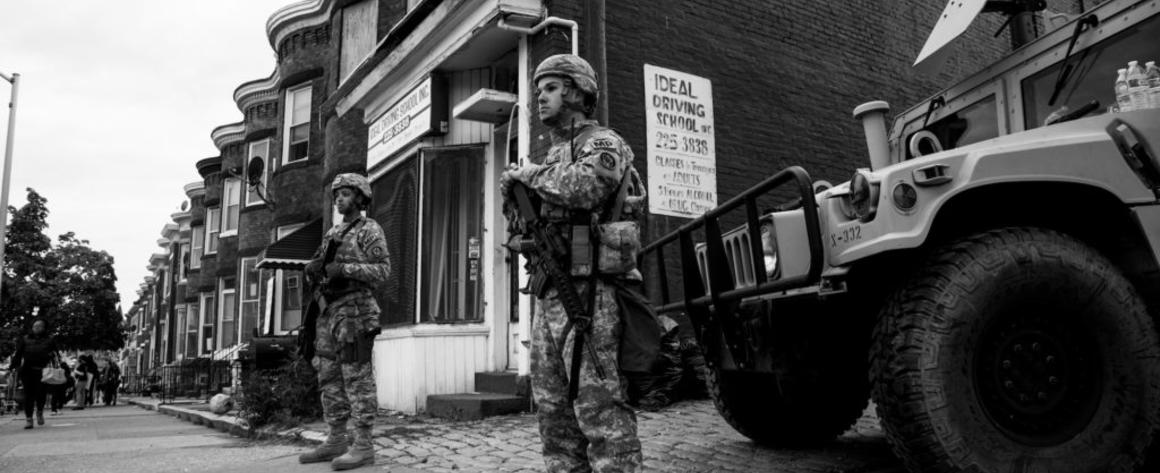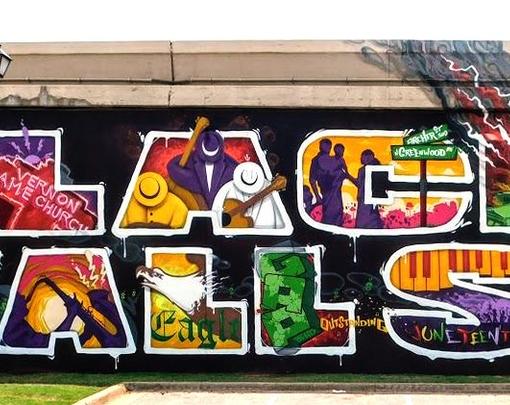A general alarm has risen in response to the recently leaked draft memo from Department of Homeland Security Secretary John Kelly outlining steps for the deployment of National Guard units, as well as other measures, across vast regions of the country to hunt down and detain those suspected of being undocumented immigrants to the United States. The Trump administration has sought to distance itself from the memo, pointing out that it is a Department of Homeland Security (DHS) and not a White House document. While this only raises further questions about the relationship of the White House to the rest of the federal executive, it also fails to put to rest concern over the potential use of the National Guard against millions of members of our society. Furthermore, it raises profound questions about who commands the Guard, whom the Guard serves, and beyond these, the role of military organizations in either strengthening or undermining democracy in the twenty-first century.
Newfound concern over the dangerous directions indicated by the DHS memo draws attention to what some of us have been arguing for years—namely, that a restored, reformed, and much expanded National Guard system should take over primary responsibilities for American security from the contemporary military establishment. To get there, it will be helpful to take a crash course in the law and the history of the National Guard.
Let’s begin with Governor Asa Hutchinson of Arkansas, who responded to the leaked DHS memo with a revealing statement: “I would have concerns about the utilization of National Guard resources for immigration enforcement with the current deployment responsibilities our guardsmen have overseas.” Other governors raised similar concerns. Such juxtapositions of overseas versus domestic deployments tell us a great deal about the constitutional and legal frameworks that govern the National Guard. They are a terrible mess.
The Constitution of the United States disallows the use of the National Guard to invade and occupy other countries. Instead, Article 1, Section 8 provides for the use of the Guard “to execute the laws of the Union, suppress insurrections, and repel invasions.” Federal statutes enacted under the authority of the Constitution describe the conditions under which the Guard may and may not be used for domestic law enforcement. Most readings of those statutes are that they do not authorize the unilateral federalization of state guard units to hunt down and detain those suspected of being undocumented immigrants. Yet as a matter of constitutional law involving at least several of the militia clauses and the Bill of Rights, the question is unclear.
What is clear is that National Guard law is currently broken. The United States have not been invaded since 1941, yet over the past year, National Guard units were deployed in 70 countries, reflecting former Secretary of Defense Donald Rumsfeld’s statement that, “There’s no way we could conduct a global war on terror without the Guard and Reserve.” At the same time, a potentially constitutional use of the Guard against immigrants has been met with immediate and broad criticism that reveals an opposition mostly unprepared to engage in a debate about what the Guard is, what it was originally supposed to be, and what it could or should be.
The History of the Guard
“What, Sir, is the use of a militia? It is to prevent the establishment of a standing army, the bane of liberty…. Whenever Governments mean to invade the rights and liberties of the people, they always attempt to destroy the militia, in order to raise an army upon their ruins.”
—U.S. Rep. Elbridge Gerry, Massachusetts, August 17, 1789.
The National Guard are the organized and regulated militia of the United States, and the origins of the Guard are with the revolutionary state militia of the 1770s and 1780s. For a variety of historical reasons having to do with the colonial and pre-colonial histories of working class and middle class radicalisms, the revolutionary generation recognized in standing armies a mortal threat to republican self-government. Thus, the Constitution provides numerous checks on the capacity of the federal government—and, in particular, of the executive branch—to engage in the making of war and in the use of military power. These constitutional checks include locating the war declaring power with Congress, the administrative supervision and financial oversight of the military with Congress, the entitling of the President with the office of Commander in Chief only in times of war, and the centralization of national defense policy around the existing militia system as opposed to a large professionalized standing army.
All of those provisions remain present today in constitutional text, but most of them are absent from constitutional practice. In a chapter published in Come Home America, as well as in various other articles, papers, and books, I have previously argued that the twentieth century transformation of the militia system from a more democratic and decentralized institution into a subsidiary of the U.S. Armed Forces made possible the destruction of all the other checks on executive war powers and empire building. Here I’ll briefly summarize those arguments.
In its first century, the militia system largely functioned for good and for ill as was originally intended: to repel invasion, to suppress insurrection, and to enforce the law. Where the militia did not function well was in the invasion and occupation of other nations and countries. This was true in the wars against North America’s indigenous peoples, and it was made especially apparent in the largely failed efforts at the end of the nineteenth century to rapidly transform militia units into Army units for the occupations of the Philippines, Guam, and Cuba. Thereafter, with each of the twentieth century’s wars, from the Spanish American War on through the World Wars, the Cold War, the U.S. occupations of Iraq and Afghanistan, and the so-called Global War on Terror, Americans have experienced the increasing nationalization of the state-based militia of the United States into the National Guard and Reserves.
This transformation not merely accompanied the rise of the modern U.S. warfare state, it has been a necessary precondition for it. Where Abraham Lincoln often cited his first experience with public office in his election to captain in the Illinois militia, the election of officers is gone from the practice of the U.S. military. Where various militia units refused to participate in the invasions and occupations of Canada, Mexico, Indian country, and the Philippines, today such refusal would provoke a constitutional crisis. Where in 1898 there were eight men under arms in the U.S. militia for each one in the U.S. Army, today the National Guard is folded into the reserves of the U.S. Armed Forces. The destruction and incorporation of the traditional militia system was a prerequisite for the emergence of twentieth century U.S. imperialism.
As an instrument of domestic law enforcement, the transformation of the Guard has been less complete. In the nineteenth century, Southern militia units suppressed slave revolts and Northern units resisted slave hunters; some militias terrorized free Blacks and other militia organized by former slaves safeguarded Reconstruction; some units massacred striking workers and others joined strikes. This dynamic has continued into the twentieth and twenty-first centuries, as the Guard was used both to deny and to enforce civil rights in Little Rock and Montgomery; to suppress urban uprisings and student protests from Los Angeles to Milwaukee; to establish martial law at the Seattle WTO protests of 1999—and to refuse to do so during the Wisconsin Uprising of 2011. Presidents George W. Bush and Barack Obama worked with the governors of border states to deploy Guard units to border control, but as we’ve seen over the past week, the prospect of the use of the Guard to directly apprehend undocumented immigrants has been met with widespread resistance.
Toward a Democratized System of Defense
It’s unquestionably a good thing that, for all that has been done to the National Guard, the institution of the Guard remains contested terrain. This has been true not only in the reaction to the DHS memo, but even more so in periodic organized efforts of those serving in the military, veterans, military families and friends, lawyers and democracy advocates to confront unlawful uses of the Guard. In the 1980s, the governors of several states challenged the use of the Guard to train the Nicaraguan Contras. From 2007-2009, the Liberty Tree Foundation coordinated a twenty-state “Bring the Guard Home!” campaign to require governors to review federalization orders for their legality and to refuse unlawful attempts to send state Guard units overseas. These efforts failed to achieve their immediate aims, but they opened critical public debates that may point the way forward for the democratization of national security.
In reviewing the history of the National Guard, we see multiple examples of what the law in action tradition in legal theory teaches: that the law and the rule of law operate not only in text or in formal legal institutions but more so in the ways in which law is practiced and experienced across the breadth and depth of social life. If the text of the U.S. Constitution allocates war powers primarily to Congress and to the state militia, but the material condition of the military is constituted in a way that empowers the executive branch, then decisions about war and peace, as well as public order and civil liberties, will be made by the President. For a democratic society to emerge and flourish, it is essential for the actual constitution of power to operate in a way that democratizes. To me, such a recognition suggests a number of reforms to our system of national defense, including:
- Expansion of the mission of the National Guard to much more explicitly recognize its current roles in disaster relief, humanitarian services, as well as new services in conservation, energy transition, urban and rural reconstruction, and other critical areas;
- Reconfiguration of the Guard as part of a system of universal service in which every citizen and resident of the United States participates in during young adulthood—and which, in turn, is part of a compact providing free public higher education and other civic services;
- The restoration of voting, including the election of officers, to the National Guard system;
- A restructuring of the funding and regulation of the Guard so as to insure that the state units enter into war operations only in response to invasion, as provided for in the Constitution;
- A commensurate restructuring of the U.S. Armed Forces in subordination and service to the Guard system;
- Adoption of a war referendum amendment, as proposed in the 1920s following World War I and in the 1970s at the end of the Vietnam War, requiring a national referendum before the United States enters into any non-defensive conflict; and
- A marked increase in active peacemaking as a matter of American policy, in part through a strengthened and democratized United Nations, such that the U.S. spends at least ten times as much on creating the conditions for peace as it does in preparing for the possibility of war.
There are those who say that none of this goes far enough, pointing out that war has already been outlawed by various treaties to which the United States is a signatory, particularly the Kellogg-Briand Pact of 1928. They are, of course, correct. But such treaties, like the Constitution that makes them “the Supreme law of the Land,” only enjoy legal force in the actual constitution of power. A democratized system of defense is the surest safeguard for both peace and democracy. The widespread public consternation at the potential deployment of the National Guard for immigration enforcement purposes ought therefore to become the jumping off point for a far more fundamental exploration and debate around how we constitute ourselves as a people for the protection and defense of our rights and liberties.




